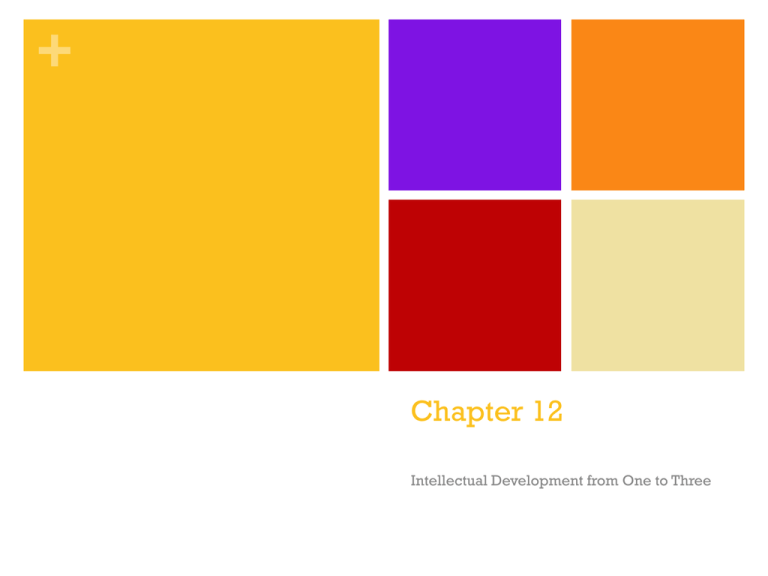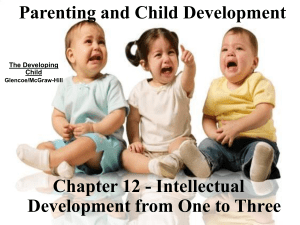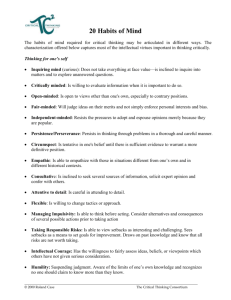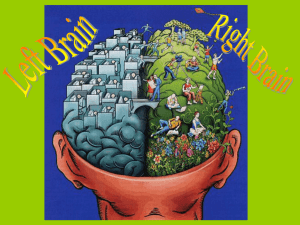Chapter 12
advertisement

+ Chapter 12 Intellectual Development from One to Three + Chapter Objectives Summarize how heredity and the environment shape intelligence Describe 4 methods of learning used by young children List the 7 areas of intellectual activity List 11 ways to help guide a child’s learning Identify 4 parts of language that children have an inborn ability to decipher Summarize how to evaluate toys for young children + 12.1 Brain Development from One to Three Intellectual Development from One to Three + Brain Development Discussion Starter Why can a 3-year old perform more tasks than a 1-year old? New Term: Neuroscience Is the modern study of the brain + The Role of Intelligence Intelligence is the ability to interpret and understand everyday situations and to use prior experiences when faced with new situations or problems The ability to learn Shaped by heredity and environment Toddlers and preschoolers form attitudes about learning that can last a lifetime Given many opportunities, children will develop positive attitudes toward learning + Concept Development Concepts are general categories of objects and information Young children often over-apply labels: EX: all round objects are balls OR all animals are dogs First categorize things by shape, color, and size Balls are round, so are cookies and plates Grass and leaves are green Relationship between big and little may not be realized until 18 months Concepts regarding what is alive and what is not wont be developed until later (clouds, toys, cartoon characters, etc.) Concepts of time improve during these years Show more patience “Soon” now has meaning + Methods of Learning Piaget’s Four Periods of Learning Age Characteristics Sensorimotor Children learn through their senses and own actions Preoperational (2-7 Years) Children think in terms of their own activities and what they perceive at the moment Concrete Operations Children can think logically but still learn best through experiences Formal Operations People are capable of abstract thinking + Methods of Learning Incidental Learning Incidental learning is unplanned learning Example: Five month old Evan pushes a button on a musical toy and discovers that this action causes music to play. After this happens a few times, Evan learns a cause-and-effect situation. Then he pushes the button on purpose to hear music + Methods of Learning Trial-and-Error Learning Trial-and-Error learning is learning that takes place when a child tries several solutions to find one that works At about 12-18 months this is seen as experimenting More advanced for a 3 year old Example: Krista is a 3 year old and wants to play with the robot her brother is playing with. First, Krista grabs the robot, her brother cries and mom makes her give it back Next, Krista asks if he wants to go play in the sandbox, he says no. Finally, she offers up one of her favorite toys and her brother hands over his robot. + Methods of Learning Imitation Imitation is learning by watching and copying others Older children become annoyed when a younger sibling copies everything they do The younger child uses the older child as a model for behavior of all kinds Both skills and attitudes can be imitated EXAMPLE: A toddler watches an adult on the telephone and picks up an inanimate object and pretends it’s a phone + Methods of Learning Directed Learning Directed learning results from being taught, often by parents, or other caregivers, teachers, or older siblings Occurs in schools or other areas of formal instruction like the home Direct learning involves an older person purposely teaching a specific skill EXAMPLE: Joel’s kindergarten teaching helps him learn the letters of the alphabet by showing pictures of items that begin with the same letter + Intellectual Activity Areas Attention To adults, in order to complete tasks, we have to focus our attention on one thing; blocking out much of the extra sensory information. Infants and young children cannot do this. Young children and infants attention bounces back from one sensory bit of information to another rapidly as they try to make sense of all the messages EXAMPLE: while putting a child’s shirt on and reaching for their pants, they have wondered out the door to see what was going on in the next room The more a child can block out extra sensory information, the better they can learn and focus their attention skills + Intellectual Activity Areas Memory Older children and adults have long-term and short-term memory Short-term memory is brief and allows people the accomplish many every day tasks without making the brain store that information EX: remembering a phone number long enough to call Long-term memory is for more important data First it enters short term memory Second it is judged on its importance Last it is stored in long-term memory Babies demonstrate memory early A 1-year old who was frightened by a dog may be afraid of all animals for a time A 3-year old will remember the specific dog and compare it to others 3-year olds can also recall a celebration and look forward to the next one Develop long-term memory skills at age 3 + Intellectual Activity Areas Perception Perception is the information received through the senses Caregivers play a key role in the development of perception Simply talking about what you and the child are doing can help perception Use descriptive observations that a child can understand and expand on Reinforced as connects with established parts in the brain EX: “ Look at the blue block. Your shirt is blue too. Let’s build a tower using only blue blocks.” 2 and 3 year olds seem to always ask questions “why?” “What’s that?” Responding to the questions will help further perception Always answer a question, if left unanswered a child’s perception of asking questions has been damaged + Intellectual Activity Areas Reasoning Necessary to solve problems and make decisions Making decisions involves choosing from different alternatives Recognize relationships and form concepts Children learn through practice to make good choices First, let the child choose between two options (both not causing harm) A 1-year old can choose between two books at bedtime A 3-year old can choose between two different shirts Caregivers need to take note about asking questions that can elicit (bring about) negative responses EX: Instead of asking “Would you like to have fish for dinner?” ask “Would you like peas or corn with your fish for dinner?” + Intellectual Activity Areas Imagination Very prominent about 2 years of age Active imaginations improves learning because it allows the child to try new things Child can act out a variety of roles Children use imagination to convey what they see and hear themselves Important to respect and respond carefully to a child’s imagination They may use imagination as a tool for controlling their fears EX: throwing a monster out the window + Intellectual Activity Areas Creativity Creativity is a mental ability that involves using the imagination to produce original ideas Often displayed through objects for others to see May also be in daydreams, dramatic play, or silly stories Mostly developed during early childhood and lasts a lifetime Promotes self-esteem and confidence How to encourage creativity? Allow the child free time or uninstructed play + Intellectual Activity Areas Curiosity Curiosity helps develop the brain and learning Curiosity is what makes children want to know more about the world around them Parents can accidentally stifle curiosity by overprotecting the child Toddlers are extremely curious about the world around them They get into everything; peeking around every corner They become very curious about their parents and caregivers activities Encourage curiosity whenever possible If a child wants to stop during a walk and watch a snail, its stimulating to their brain development Let’s Review! 1. 1. Why is it vital that young children have a stimulating environment? + 2. 2. Describe how trial-and-error learning supports Piaget’s description of the Sensorimotor period 3. 3. Why is curiosity important? + 12.2 Encouraging Learning from One to Three Intellectual Development from One to Three + Brainstorm What might be some interesting daily routines that would be excellent learning opportunities for this age group? + Guiding for Learning Reading Readiness Depends on a large part of the caregivers environment they create Reading to a toddler should be a well-established daily routine Interact with young children while reading Have them predict the story Reading Readiness means learning the skills necessary for reading, including letter recognition and the understanding that letters from the alphabet combine to form words on a page Before age 3, reading readiness focuses on exciting a child about reading Last stage of reading readiness is letter recognition Understanding that letters from the alphabet combine to form words Encourage children to guess each letter and praise when they guess correct + Reading Readiness Bedtime Accomplishes More Than You Think! Children learn how to handle books and turn pages They begin to associate written words that appear on the page with words being read aloud Finishing a book creates a sense of accomplishment Especially when the child can read some of the text. + Readiness for Learning Math Readiness Math readiness is the level of knowledge of basic math concepts Number recognition is a large concept Like reading, caregivers need to make learning math enjoyable Explore sizes, shapes, amounts, and proportions long before they enter a formal classroom Counting and number recognition can be taught by making game for finding numbers “Are there two bananas left this morning or only one?” How quickly can a child find the number 3 in a grocery store Blocks and puzzles also help shape recognition Also help in learning shape names Sorting is a good mathematical skill Sort items by color, shape, and size + Readiness for Learning Guide for Learning Suggestions to guide learning 1. 2. 3. 4. 1. 2. 3. 4. 5. 6. 7. Give your time and attention Allow time for thinking Give only as much help as the child needs Encourage children to draw their own conclusions Demonstrate how to solve problems Model problem solving Maintain a positive attitude Keep explanations simple Allow children to explore and discover Help children understand the world and how it works Take frequent breaks 1. Children need unconstructed play time + Language Abilities Speech Development Between a child’s 1st and 2nd birthdays, children work at learning new words At 12 months a child may speak 2 to 8 words By age 2, it jumps to 50 words At this time, children will use 1-2 words versus an entire sentence to express themselves Encourage language development by talking to young children about their lives At age 2, children should start developing small sentences “Doggie bark” At 2-1/2 years of age, children begin to learn basic grammar rules Children will add an “s” onto words to make them plural Most 3-year olds can: Say their name and age Make all vowel sounds and say all consonants Speak without repeating a word or syllable Use sentences of at least 4 words Be understood by others Answer what and where questions Understand what is meant by words like us, in, or under Follow simple commands + Speech Development Sign Language Baby sign language is a way to teach infants how to communicate using hand gestures Hand gestures are easier for a child to communicate using hand movements versus their vocal cords (Fine vs Gross motor skills) Studies have shown that children that use sign language to communicate are about 1 full year ahead in other areas of language and speech development Baby Sign Language.com + Language Abilities Speech Difficulties A child that does not seem to understand what is said, does not speak at all, or speaks very little should be thoroughly examined Most public school districts provide hearing tests CAREER: A speech-language pathologist is a specialist who is trained to detect and help correct speech problems Some difficulties can be treated as early as 3 years of age Hearing problems, learning disabilities, and mood disorders can affect speech development + Speech Difficulties Articulation Articulation refers to the ability to use clear, distinct speech Its normal for children to have trouble articulating words until at least age 4 Skip syllables or leave off endings of words Most problems correct themselves over time Instead of correcting pronunciation of words, set a good example by saying words correctly Instead of saying “ba-ba” say “bottle” + Speech Problems Stuttering Stuttering is when a person speaks with a sporadic repetition or prolonged sound Some parents mistake hesitations in speech for stuttering True stuttering can be identified by the rhythm, pitch, and speed of speech It is rapid, forced, short, and sharp in sound “I c-c-c-can’t g-g-g-go outside” Causes are not completely understood “ Johnny…Johnny….Johnny. He….he…he hit Zoe!” In this case the child’s language development is still immature Some overcome with speech therapy Some outgrow it Never finish a child’s words, children need time to finish on their own + Playtime! Toy Selection One-Two Years Two-Three Years Motor control Large muscle Exploration Metal pans, wooden spoons, etc. Coordination is key Child-size vacuum cleaner or lawn mower, telephone, plastic or wooden tools Crayons, play dough, books Three-Four Years Improved motor skills IMAGINATION Dolls, construction sets, dress up clothes Music Puzzles Large gross motor skills








